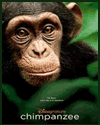| A Few Words with the Directors of Chimpanzee |
|---|
| www.studenthandouts.com ↣ Miscellaneous ↣ News Archives ↣ 2012 News Archives |
In anticipation of the Earth Day release of Disney Nature's Chimpanzee, wildlife documentary directors Alastair Fothergill and Mark Linfield sit down to discuss the 3 ½ years spent filming this remarkable story of animal life in the African jungle. Do you love animals, travel, and adventure? Can you imagine yourself spending years in the African jungle filming animals? Are you prepared to go up against blistering heat, 100% humidity, and bugs (like mango fly larvae) that can burrow under your skin? Then you may want to consider becoming a wildlife documentary film director like Alastair Fothergill and Mark Linfield. The pair collaborated on Disneynature's Chimpanzee (released into U.S. theaters April 20, 2012). They were kind enough to share some of their experiences shooting this film, as well as to offer advice to budding young documentary filmmakers.
Do you love animals, travel, and adventure? Can you imagine yourself spending years in the African jungle filming animals? Are you prepared to go up against blistering heat, 100% humidity, and bugs (like mango fly larvae) that can burrow under your skin? Then you may want to consider becoming a wildlife documentary film director like Alastair Fothergill and Mark Linfield. The pair collaborated on Disneynature's Chimpanzee (released into U.S. theaters April 20, 2012). They were kind enough to share some of their experiences shooting this film, as well as to offer advice to budding young documentary filmmakers.Interview and Publication Date for Citations: April 17, 2012 Tip #1: Know Your Animals As with any film, you need to understand your subject matter. Mark Linfield originally trained as a zoologist, and first worked filming gorillas in the Congo. Alastair Fothergill likewise trained in zoology, and began his career filming nature programs for the BBC Natural History Unit. According to Fothergill and Linfield, you cannot work with just any animals. In this film, the directors had to work with habituated chimpanzees—that is, chimps who aren't afraid of human beings. The pair, who are (when not filming abroad) based in Bristol, England, worked with the scientist Christopher Boesch (of the Max Planck Institute in Leipzig, Germany), selecting a chimpanzee group he was already studying and familiar with. Even under these circumstances, it took the chimpanzees quite a bit of time to get used to the film crew. Adding to these difficulties was the reality that, just like people, some chimps are camera shy. The takeaway? Creating a wildlife documentary requires a lot of learning, research, scientific expertise, patience, dedication, and hard work. Tip #2: Be Prepared to Change the Script Chimpanzee, like other films in the Disneynature series, is a "True Life Adventure," meaning that documentary footage is used to tell a story, rather simply relay factual information about the subject. When Fothergill and Linfield went to Africa, they had a script, and hoped to capture enough footage of chimps that fit this script. But plans don't always work out. "One of the things we've been trying to do at Disneynature is not make documentaries. We try to make movies that really work in a sort of way that movies are supposed to work... We have stories and engaging characters, and the fact that they're chimpanzees is wonderful, but actually, they've got to work as characters." (Alastair Fothergill) Before too long, the filmmakers found themselves captivated by a mother and son—Isha and Oscar. Soon enough, the directors realized that Isha and Oscar were destined to be the stars of this story. Then, tragedy struck, and Oscar found himself orphaned. What would happen to the star of this movie—a movie that was being written as it was being filmed? Amazingly, Oscar was adopted by the alpha male in his group, a chimpanzee named Freddy. The adoption of an orphaned chimp by an alpha male had only ever been reported once in the entire history of primate research, and had never been captured on film before. Yet here it was, happening as the cameras rolled. The takeaway? Don't be rigid about your original plans. Be willing to change things as you go along.You might find that the end result is better than your original vision. |
 | Mark Linfield (left) and Alastair Fothergill, directors of Disneynature's Chimpanzee (April, 2012). |
|
Tip #3:
Don't Wait to Get Started Directing If you're eager to find out if wildlife documentary filmmaking is right for you, don't wait to get started. According to Mark Linfield, with the low cost of today's video equipment, budding directors can begin filming in their own homes and backyards. "There's been a great sort of democratization, if you like, of video...not only the really good, high-quality, cheap video cameras around, but even iPhones and stuff. You literally can go out and shoot your own movie of your cat, or you can go to the zoo. You can actually just play around with shooting and editing your own stuff and telling stories, and just see if you've got a natural aptitude for it. It used to be that you needed kind of expensive gear and lots of people with big tripods, and now anyone can do it. Most still cameras have got video modes on them. Just shoot some stuff and edit it on your computer. Have some fun." (Mark Linfield) The take away? If you really want to try something, don't just dream about it—get out there and start doing it. Interesting Facts (Spoiler Alert): Scientists did genetic testing on Freddy and Oscar, and the two chimps are not related. No one knows exactly what happened to Isha, but the scientists assume she was killed by leopards. The filmmakers had no trouble identifying each chimp, because chimpanzee faces are as distinguishable as human faces. Stay in the theater for the closing credits, with plenty of "extra" footage of the film crew battling the elements and other jungle critters. No word yet on the next film, but Mark Linfield and Alastair Fothergill will definitely be doing more work with Disneynature in the future. |
|
Chimpanzee Movie Review Jane Goodall Institute Roots and Shoots Program Disneynature Interview with Jane Goodall |
 |  |  |  |
| www.studenthandouts.com ↣ Miscellaneous ↣ News Archives ↣ 2012 News Archives |








